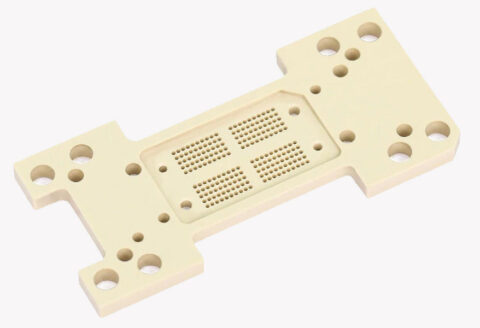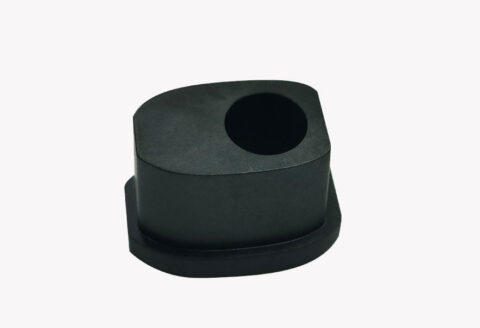
Polyetheretherketone (PEEK) is a high polymer composed of repeating units containing one ketone bond and two ether bonds in the main chain structure, and is a special polymer material. It has physical and chemical properties such as high temperature resistance and chemical resistance. It is a kind of semi-crystalline polymer material. It can be used as high temperature resistant structural material and electrical insulating material. It can be compounded with glass fiber or carbon fiber to prepare reinforcing material. Generally, a type of polyarylene ether polymer obtained by condensation with aromatic dihydric phenol is used. This material has numerous applications in aerospace, medical devices (as artificial bone to repair bone defects) and in industry.
PEEK (polyetheretherketone) plastic raw material is an aromatic crystalline thermoplastic polymer material with high mechanical strength, high temperature resistance, impact resistance, flame retardant, acid and alkali resistance, hydrolysis resistance, wear resistance, fatigue resistance, radiation resistance and good electrical properties.
- High temperature resistance: It has high glass transition temperature (Tg=143°C) and melting point (Tm=343°C), its thermal deformation temperature under load is as high as 316°C, and its instantaneous use temperature can reach 300°C.
- Mechanical properties: It has rigidity and flexibility, especially the fatigue resistance under alternating stress is very outstanding, which is comparable to alloy materials.
- Self-lubrication: It has excellent sliding properties and is suitable for occasions where low friction coefficient and wear resistance are strictly required, especially PEEK modified with carbon fiber and graphite in a certain proportion has better self-lubricating properties.
- Corrosion resistance: Except for concentrated sulfuric acid, PEEK is insoluble in any solvent and strong acid and alkali, and it is resistant to hydrolysis and has high chemical stability.
- Flame retardancy: It is self-extinguishing, even without any flame retardant, it can reach the 94V-0 level of the UL standard.
- Ease of processing: It has the characteristics of good high temperature fluidity and high thermal decomposition temperature. Various processing methods can be used: injection molding, extrusion molding, compression molding and melt spinning.
- Peeling resistance: The peeling resistance is very good, so it can be made into a thinly coated wire or magnet wire, and can be used in harsh conditions.
- Fatigue Resistance: The best fatigue resistance among all resins.
- Radiation resistance: The ability to withstand high radiation is very strong, surpassing that of polystyrene, which has the best radiation resistance among general-purpose resins. It can be made into a high-performance product that can maintain a good insulating ability when the γ-irradiation dose reaches 1100Mrad.
- Hydrolysis resistance: PEEK and its composite materials are not chemically affected by water and high-pressure water vapor, and products made of this material can maintain excellent properties when used continuously in high-temperature and high-pressure water.
- Smoke: PEEK has the lowest smoke among plastics.
- Toxic gas emission: PEEK is the same as many organic materials. When decomposed at high temperature, PEEK mainly produces carbon dioxide and carbon monoxide. Using the British aircraft test standard BSS 7239, a very low concentration of toxic gas can be detected. This detection process needs to be in 1. Completely burn 100 grams of sample in a cubic meter of space, and then analyze the poisonous gas produced in it. The toxicity index is defined as the ratio of the concentration of poisonous gas produced under normal conditions to the lethal dose in 30 minutes. The index of PEEK450G is 0.22. And no acid gas was detected.
- Insulation stability: has good electrical insulation properties and maintains it to a very high temperature range. Its dielectric loss is also small at high frequencies.
- Stability: Has excellent dimensional stability properties, which is important for some applications.
Changes in environmental conditions such as temperature and humidity have little effect on the size of PEEK parts, which can meet the requirements for use under high dimensional accuracy requirements.
- The injection molding shrinkage of PEEK plastic raw materials is small, which is very beneficial to control the dimensional tolerance range of PEEK injection parts, so that the dimensional accuracy of PEEK parts is much higher than that of general-purpose plastics;
- The thermal expansion coefficient is small, and with the change of temperature (caused by the change of ambient temperature or frictional heat generation during operation), the size of PEEK parts changes very little;
- Good dimensional stability. The dimensional stability of plastics refers to the dimensionally stable performance of engineering plastic products during use or storage. This dimensional change is mainly due to the increase in the activation energy of polymer molecules. caused by some degree of curling;
- PEEK has outstanding heat-resistant hydrolysis properties, low water absorption under high temperature and high humidity environment, and there is no obvious change in size of general-purpose plastics such as nylon due to water absorption.
The Preparation Of Polyetheretherketone
It is prepared from 4,4′-difluorobenzophenone, hydroquinone and potassium carbonate as raw materials and diphenylsulfone as solvent.
Polyetheretherketone (PEEK) is prepared by nucleophilic substitution method. It is prepared by polycondensation of 4,4′-difluorobenzophenone and hydroquinone in diphenylsulfone solvent under the action of alkali metal carbonate. The reaction formula is as follows:

The polycondensation reaction is carried out at a temperature of 150°C to 340°C. The initial reaction temperature should be low to avoid loss of hydroquinone and reduce side reactions. Then the temperature was raised slowly, the polymer was dissolved in the solvent, and the reaction was completed at 320°C.
The polymer molecular weight depends on the molar ratio of difluorobenzophenone to hydroquinone. The two are usually in an equimolar ratio, and if the former is in a slight excess, the polymer will contain fluorine end groups. Fluorine end groups are more thermally stable than phenolic end groups.
The alkali metal carbonate is usually a mixture of potassium carbonate and sodium carbonate, and the amount is at least 2 mol per 1 mol of hydroquinone (the alkali metal carbonate corresponds to at least one hydroxy group corresponding to at least one alkali metal atom). If the ratio of alkali metal carbonate to hydroquinone is too low, the polymer will be brittle; if the ratio is too high, a series of side reactions will be induced and the product properties will be affected.
The polycondensation reaction was carried out in a stainless steel reactor with a stirring device. Add the raw material difluorobenzophenone, hydroquinone and solvent diphenyl sulfone (the amount is about 2 to 3 times that of difluorobenzophenone) into the polymerization reactor, pass nitrogen and heat up to 180 ° C, add The mixture of anhydrous potassium carbonate and sodium carbonate is heated to 200°C for 1 hour, then heated to 250°C for 15 minutes, and finally heated to 320°C for 2.5 hours. The reactants were withdrawn from the reactor and cooled to a hold-up tank. The polymer crystallized out together with inorganic salts, sodium fluoride, potassium fluoride, and diphenylsulfone. The carbon dioxide and nitrogen generated in the reaction are condensed and vented.
After the polymer in the tank is pulverized, it is screened with a fine sieve of 500 pm aperture, and then sent to an extractor, extracted with acetone, the suspension is filtered through the first and second filter presses, and the precipitate is washed with acetone to remove diphenylsulfone . The filtrate is sent to the crystallizer, diphenylsulfone and acetone are recovered, and the filter cake is sent to the water washing tank, and washed with water to remove the inorganic salts in the polymer. After the suspension is filtered by the third and fourth filter presses, the filtrate is sent to the solvent for recovery, and the filter cake after pressure filtration is sent to the dryer for drying to obtain the product.
The Application Of Polyetheretherketone
Due to its excellent comprehensive properties, PEEK can replace traditional materials such as metals and ceramics in many special fields. The properties of high temperature resistance, self-lubrication, wear resistance and fatigue resistance of this plastic make it one of the most popular high-performance engineering plastics today, and it is mainly used in aerospace, automobile industry, electrical and electronic and medical equipment and other fields.
- Aerospace field: It can be processed into various high-precision aircraft parts. Due to its good hydrolysis resistance, corrosion resistance and flame retardant properties, it can be processed into internal/external parts of aircraft and many parts of rocket engines.
- Automobile manufacturing: PEEK has been successfully used in automobile manufacturing. Because of its good friction resistance, it can replace metals (including stainless steel and titanium) to manufacture engine inner covers, automobile bearings, seals and brake pads, etc. .
- Industrial field: Because of its good mechanical properties, high temperature resistance, wear resistance, and high pressure resistance, it is often used to manufacture compressor valve plates, piston rings, seals, etc.
- Medical equipment: It can withstand 3000 cycles of high pressure sterilization at 134 ° C. This feature can meet the requirements of high sterilization and the manufacture of surgical and dental equipment that needs to be used repeatedly, plus its creep resistance and hydrolysis resistance. , which can be used to manufacture various medical devices that require high-temperature steam sterilization. It is particularly important that PEEK is non-toxic, lightweight and corrosion-resistant, and is the material closest to human bones, so PEEK can be used instead of metal to make human bones.
- Insulating material: PEEK has excellent electrical properties. Under harsh conditions such as high temperature and high humidity, the insulating properties of polyether ether ketone can still be maintained. It is an ideal electrical insulating material, especially in the semiconductor industry. Widely used .
- It is a new type of engineering plastic, which can be used as high temperature resistant structural material and electrical insulating material, and can be compounded with glass fiber or carbon fiber to prepare reinforcing material.
- Modified polyetheretherketone includes black carbon fiber reinforced conductive polyetheretherketone, red carbon fiber reinforced conductive polyetheretherketone, mineral reinforced polyetheretherketone, glass fiber reinforced polyetheretherketone and PEEK resin. Although polyetheretherketone has many excellent properties, its high price limits its application in some fields. In addition, its impact strength is poor. In order to further improve its performance and meet the comprehensive performance and diversified needs of various fields, it can be modified by filling, blending, cross-linking, grafting and other methods to obtain performance. Better PEEK plastic alloys or PEEK composites. For example: PEEK and polyether can be blended to obtain better mechanical properties and flame retardancy; PEEK and PTFE are blended into composite materials, which have outstanding wear resistance and can be used to manufacture sliding bearings, dynamic seal rings and other components; PEEK is filled and modified with carbon fiber to make a reinforced PEEK composite material, which can greatly improve the hardness, rigidity and dimensional stability of the material.

